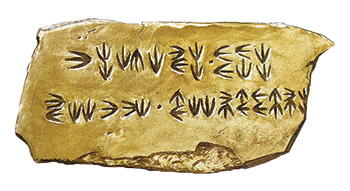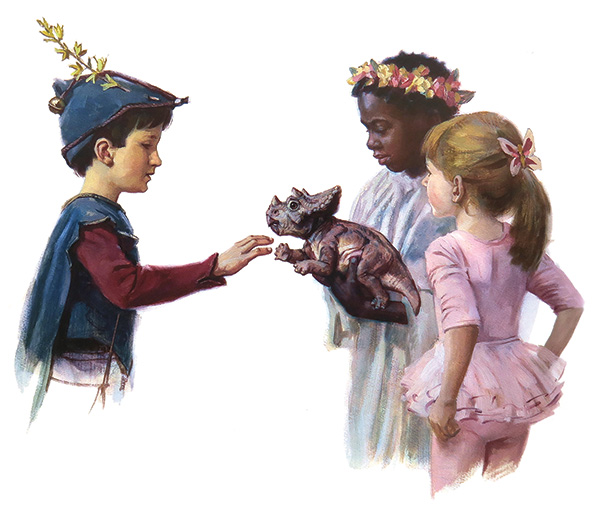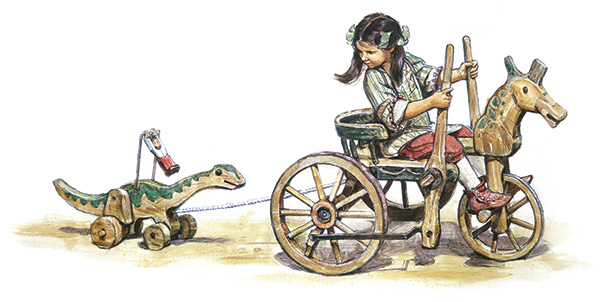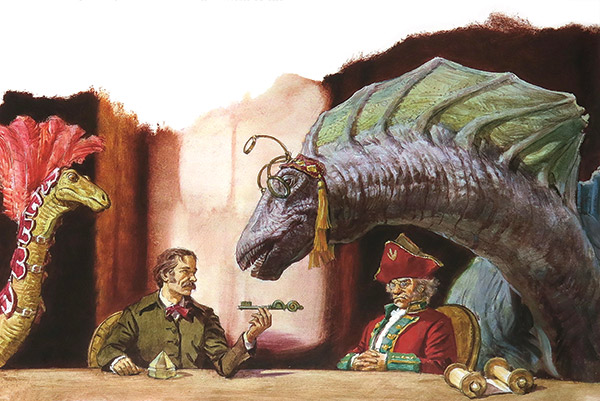Subtotal: $
Checkout
This interview was first published in the Autumn 2020 issue of Plough Quarterly.
James Gurney is the beloved author and illustrator of the book Dinotopia and its sequels. Plough editor Susannah Black asked him about his work and the world that he’s invented – a place where not only humans of many ethnicities and cultures work together in harmony, but even humans and dinosaurs live in solidarity.
Plough: The society you portray in your Dinotopia books has, obviously, captivated a huge audience. What about it do you think has been so compelling? What about that world, that alternate social reality, is compelling to you?
James Gurney: What people tell me most often is that they like the sense of immersion they feel when they read the book. Some of that comes from its being an illustrated book, which sketches out so many dimensions of an alternate universe. The reader’s imagination adds at least 50 percent to that act of conjuring, filling in the spaces between the pictures and the words. What I find compelling is trying to make the impossible seem inevitable, whether it’s a city built on a waterfall or a dinosaur philosopher.
One striking thing about the world you create is its relationship to technology. It is in no sense a primitive society: they have diving machines, hot air balloons, etc. But they also seem to be selective in what they adopt and are drawn to. What is the nature of the Dinotopian approach to appropriate technology?
As the son, grandson, and great-grandson of tinkerers, engineers, and inventors, I’ve always been fascinated by technology. In particular, I’m interested in how every obvious benefit of a new technological invention is counterbalanced by an invisible cost or compromise that may take a generation or two to recognize. There are so many examples. Even the invention of writing undercut the “palaces of memory” that preliterate societies once had. If there was a period when we might have really taken stock and considered the future more judiciously, it would have been at the advent of electricity, mass production, automobiles, airplanes, and modern communications: in other words, about one hundred and fifty years ago. It’s still recent enough and familiar enough to relate to, but it puts our modern dilemmas in some context. We’re at a similar crossroads now with the advent of robotics and AI, and I think living intentionally with technology will become even more important. I created the prequel Dinotopia: First Flight to explore those questions from a dystopian point of view. I love the idea of a utopian world that arrived at that place after having survived earlier times of struggle and suffering.

All images courtesy of James Gurney
In a similar way, Dinotopia is an urban world, but has many characteristics that I associate with the rural: integration, beauty, balance. Tell me about how you’ve chosen to portray cities in these books.

I think those qualities of integration, beauty, and balance can exist in urban worlds as well as rural ones, especially if you start by doing away with cars. I tried to include in Dinotopia everything from crowded urban life to small towns to remote and wild environments. The design of the cities is inspired by the medieval urban design of Old World cities, with their organic street grids and vernacular architecture, rather than the top-down design of more highly professionalized societies. I was also inspired by exposition architecture, such as the 1893 Chicago Exposition, which was a temporary expression of the highest ideals of the American Renaissance.
Tolkien described the imaginative work that artists, and particularly fantasy artists, do as “subcreation”: his idea was that we create because we are creatures of a creative God who has made us in his image. Does this idea have resonance with you?
I hadn’t read that idea about Tolkien. My understanding (and I may be wrong) was that he saw himself not so much as a creator or a subcreator but rather as a kind of lowly transcriber of some ancient text that already existed. Thinking this way allows the author to take himself or herself out of the position of creator. That relieves one of the burden of playing God. If you believe your fantasy world already exists, it makes the ideas come more readily to the imagination.
The sense that one gets about the world that you’ve made is that you love it: you don’t just love the characters, but the place itself. Can you talk about that love? What is it like to love something you’ve made?
Yes, I love the characters with all their flaws and I love the place with all its history. I once printed some travel tickets to Dinotopia that I give to people. The only problem, I tell them, is that they’re one-way tickets. My publishing mentor Ian Ballantine, who published Tolkien and a lot of imaginative fiction, was adamant that the purpose of fantasy literature is not to escape, but to engage. It’s fun to involve my imagination with a place that doesn’t exist, because it makes me appreciate our own world even more.

There is conflict in Dinotopia, but it is a utopia; it’s a place where harmony reigns. What is the nature of that harmony? What does the kind of interesting, non-passive, daring peace you’ve presented there mean to you?
When I was researching post-Darwinian nineteenth-century travel journals, I was struck by the view of the natural world that early explorers came back with, especially from Africa. Gorillas, whales, and even elephants were routinely called monsters and beasts. The more we get to know them, the more we discover how compassionate and sophisticated they are. Dinosaurs were and are ready for such an imaginative transformation. Some of that comes from the science – Jack Horner and other paleontologists discovered how parent dinosaurs took care of their young in nests. We humans are discovering that we can learn something from animals around us. Dinosaurs are my vehicle for that journey of discovering the harmony of nature. I have noticed that earlier nature writers like Alexander von Humboldt often speak of harmony, so maybe we’re returning to that.
The Code of Dinotopia holds that “Weapons are enemies, even to their owners.” Can you talk about this explicit pacifism? Is that a code you share?
That was an old Turkish maxim that I found somewhere. I needed a saying that started with a “W,” so that, reading down all the initial letters of the lines in the Code of Dinotopia, you could read the additional maxim “SOW GOOD SEED.” I like the Turkish proverb for the way it upends so many assumptions on various levels. I’ve always been inspired by the nonviolent examples of Martin Luther King Jr., the Dalai Lama, Gandhi, and of course Jesus. But I focused on that maxim more as a reaction to the militarization of fantasy and science fiction in so many fantasy worlds that I had grown up with, including Star Wars and Lord of the Rings. The endless battles became, frankly, too predictable and boring. I found it to be much fresher and more difficult to envision a world that had figured out how to live peacefully.

Dinotopia is, among other things, a separatist society: Dinotopians know what’s going on outside but choose not to be in contact with the outside world. Have you considered the ethics of Dinotopian separatism?
I hadn’t thought of Dinotopia as being deliberately separatist so much as having developed within an impassible region of storms and reefs. I didn’t want to deal with trade and colonialism and invasion and other sorts of mass-culture contact. I just wanted to have occasional individual shipwrecked arrivals. The inspiration is from reading James Hilton’s Lost Horizon and Heinrich Harrer’s Seven Years in Tibet. I am still fascinated by societies that are cut off from the busy interconnected world, societies such as the inhabitants of North Sentinel Island, who to this day have had only fleeting contact with the outside world. What do they make of jet flyovers and ships and plastic bottles? What did the ancient Maya know that we have since forgotten?
Dinotopia is, above all things, perhaps, civilized. That contrasts with the incivility of some characters, and of other societies either portrayed or implied. What does “civilization” mean to you?
Well, to me, “civilization” means the Greek ideals associated with being a member of a city. When I was working as an illustrator for National Geographic, I was inspired by research trips to Rome, Athens, and Jerusalem, where I could witness the physical record of how people collectively contributed to something greater and more lasting than the individual can accomplish.
The vision the books seem to conjure up is one of beauty and strangeness and adventure and harmony, both ecological and social, all at once. What would it mean to be inspired by these books to live in a different way in our world?
I’m always amazed by how people of so many different ideological perspectives have embraced Dinotopia, from fundamentalist Christians to evolutionary biologists, from socialists to old-school capitalists. That may be because I largely dodged questions of politics, religion, and economics in the books, and focused instead on pragmatic issues. I didn’t have a political or religious message driving the story. Instead the characters (with all their flaws) and the adventure are the focus of the story. I don’t have a moral to the story. People hopefully are inspired in various directions, and that’s as it should be.

James Gurney is an artist and author best known for his illustrated book series Dinotopia. He lives in Rhinebeck, New York.
Already a subscriber? Sign in
Try 3 months of unlimited access. Start your FREE TRIAL today. Cancel anytime.




















Sally Gerard
What an interesting interview for a book that my kids loved! Thank you.